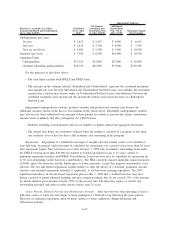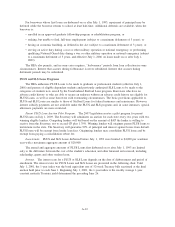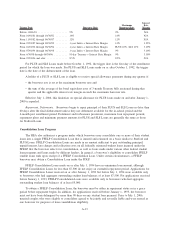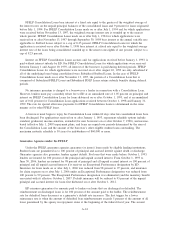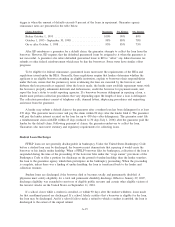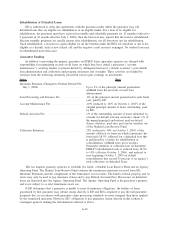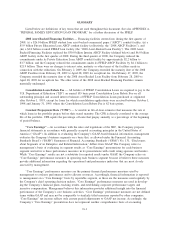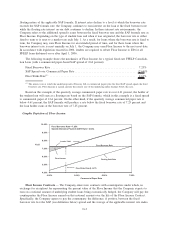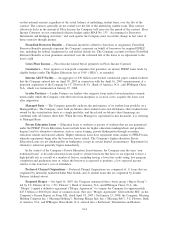Sallie Mae 2008 Annual Report Download - page 239
Download and view the complete annual report
Please find page 239 of the 2008 Sallie Mae annual report below. You can navigate through the pages in the report by either clicking on the pages listed below, or by using the keyword search tool below to find specific information within the annual report.Agreement (the “Agreement”). Under the Agreement, a lawsuit filed by the Company related to the Merger, as
well as all counterclaims, was dismissed.
Repayment Borrower Benefits — Financial incentives offered to borrowers based on pre-determined
qualifying factors, which are generally tied directly to making on-time monthly payments. The impact of
Repayment Borrower Benefits is dependent on the estimate of the number of borrowers who will eventually
qualify for these benefits and the amount of the financial benefit offered to the borrower. The Company
occasionally changes Repayment Borrower Benefits programs in both amount and qualification factors. These
programmatic changes must be reflected in the estimate of the Repayment Borrower Benefits discount when
made.
Residual Interest — When the Company securitizes student loans, it retains the right to receive cash
flows from the student loans sold to trusts that it sponsors in excess of amounts needed to pay servicing,
derivative costs (if any), other fees, and the principal and interest on the bonds backed by the student loans.
The Residual Interest, which may also include reserve and other cash accounts, is the present value of these
future expected cash flows, which includes the present value of any Embedded Fixed-Rate Floor Income
described above. The Company values the Residual Interest at the time of sale of the student loans to the trust
and as of the end of each subsequent quarter.
Retained Interest — The Retained Interest includes the Residual Interest (defined above) and servicing
rights (as the Company retains the servicing responsibilities) for our securitization transactions accounted for
as sales.
Risk Sharing — When a FFELP loan first disbursed on and after July 1, 2006 defaults, the federal
government guarantees 97 percent of the principal balance plus accrued interest (98 percent on loans disbursed
before July 1, 2006) and the holder of the loan is at risk for the remaining amount not guaranteed as a Risk
Sharing loss on the loan. FFELP loans originated after October 1, 1993 are subject to Risk Sharing on loan
default claim payments unless the default results from the borrower’s death, disability or bankruptcy. FFELP
loans serviced by a servicer that has Exceptional Performer designation from ED were subject to one-percent
Risk Sharing for claims filed on or after July 1, 2006 and before October 1, 2007. The CCRAA reduces
default insurance to 95 percent of the unpaid principal and accrued interest for loans first disbursed on or after
October 1, 2012.
Special Allowance Payment (“SAP”) — FFELP loans disbursed prior to April 1, 2006 (with the
exception of certain PLUS and SLS loans discussed below) generally earn interest at the greater of the
borrower rate or a floating rate determined by reference to the average of the applicable floating rates (91-day
Treasury bill rate or commercial paper) in a calendar quarter, plus a fixed spread that is dependent upon when
the loan was originated and the loan’s repayment status. If the resulting floating rate exceeds the borrower
rate, ED pays the difference directly to the Company. This payment is referred to as the Special Allowance
Payment or SAP and the formula used to determine the floating rate is the SAP formula. The Company refers
to the fixed spread to the underlying index as the SAP spread. For loans disbursed after April 1, 2006, FFELP
loans effectively only earn at the SAP rate, as the excess interest earned when the borrower rate exceeds the
SAP rate (Floor Income) must be refunded to ED.
Variable rate PLUS Loans and SLS Loans earn SAP only if the variable rate, which is reset annually,
exceeds the applicable maximum borrower rate. For PLUS loans disbursed on or after January 1, 2000, this
limitation on SAP was repealed effective April 1, 2006.
A schedule of SAP rates is set forth on pages A-7 and A-8 of the Company’s 2008 Annual Report on
Form 10-K.
Variable Rate Floor Income — For FFELP Stafford loans whose borrower interest rate resets annually
on July 1, the Company may earn Floor Income or Embedded Floor Income (see definitions above) based on
a calculation of the difference between the borrower rate and the then current interest rate. The Company
refers to this as Variable Rate Floor Income because Floor Income is earned only through the next reset date.
G-5


